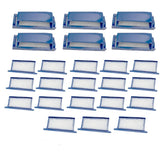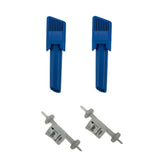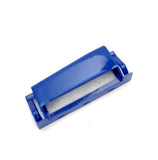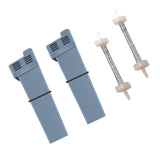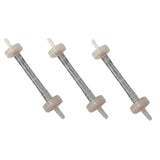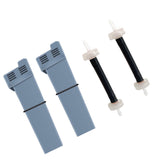Tech Tips
Tech Tips
Silicone or Natural Rubber for my CPAP Sanitizer
Silicone or Natural Rubber for my CPAP Sanitizer
We are often asked which is better, silicone or rubber? The answer is, it depends on the application. While silicone under automotive and medical conditions may be a better application, sometimes rubber is just fine. With respect to a CPAP sanitizer, the choice should be to go with a silicone upgrade over the original rubber piece. This is due to the fact that silicone is more durable in this application vs the original rubber piece. For example, the SoClean 2 CPAP sanitizer machine comes with a rubber injection hose and this can be upgraded to a heavier duty silicone version sold by Profoam.
SOME BENEFITS OF SILICONE from www.siliconehose.com:
Operating Temperature Range
Silicone hoses are capable of carrying fluids at much higher temperatures than rubber. If you’re building a racing vehicle or adding a turbocharger to your engine, silicone is the way to go. Our hoses have a max temperature of 350 degrees F (177 degrees C) compared to standard EPDM rubber hoses that have a max temperature of 257 degrees F (125 degrees C). That’s almost a hundred degrees of difference. EPDM rubber is a synthetic rubber; organic rubber performs even worse and may soften and deform irreversibly at temperatures greater than boiling point (212 degrees F / 100 degrees C).
Flexibility and resilience
Silicone hoses have superior flexibility to rubber ones, and they maintain this flexibility over their lifespan, while rubber does not. This reduces the risk that your hoses will split, explode, harden, or become dry rotted over time.
Lifespan
Silicone hoses last practically forever and might possibly outlast your machine. Because they have such a long lifespan, they can average out to a lower cost per use compared to rubber hoses, even though their upfront cost is higher.
Weather resistance
One of the advantages of silicone tubing over rubber is that it is virtually unaffected by environmental factors such rain, snow, heat, humidity, drought, UV rays, and ozone. Rubber deteriorates faster in these conditions. This makes silicone a great choice for machines that will be exposed to harsh environments.
Noise and vibration control
While rubber can be a source of noise due to the friction between the rubber and the mating surface, silicone has a good ability to dampen sounds and vibrations, keeping a quiet and stable profile. Incidentally, this is also a good argument for silicone hoses over aluminum ones, as the aluminum is a rigid material that must be coupled to a vibrating surface, requiring the use of a cushioning substance in the joints, and creating four sites that must be clamped rather than just two, effectively doubling your potential leak sites.
Inert material
Silicone is an extremely inert material that resists chemical reactions with other substances. Therefore, it won’t corrode or adhere itself to surrounding parts like the thermostat or the crossover pipe the way rubber can. It’s unlikely to bond to stems, so when you take off a hose, it’s just as easy to take off as it was to put on. This makes silicone a reliable choice for machine applications.
We are often asked which is better, silicone or rubber? The answer is, it depends on the application. While silicone under automotive and medical conditions may be a better application, sometimes rubber is just fine. With respect to a CPAP sanitizer, the choice should be to go with a silicone upgrade over the original rubber piece. This is due to the fact that silicone is more durable in this application vs the original rubber piece. For example, the SoClean 2 CPAP sanitizer machine comes with a rubber injection hose and this can be upgraded to a heavier duty silicone version sold by Profoam.
SOME BENEFITS OF SILICONE from www.siliconehose.com:
Operating Temperature Range
Silicone hoses are capable of carrying fluids at much higher temperatures than rubber. If you’re building a racing vehicle or adding a turbocharger to your engine, silicone is the way to go. Our hoses have a max temperature of 350 degrees F (177 degrees C) compared to standard EPDM rubber hoses that have a max temperature of 257 degrees F (125 degrees C). That’s almost a hundred degrees of difference. EPDM rubber is a synthetic rubber; organic rubber performs even worse and may soften and deform irreversibly at temperatures greater than boiling point (212 degrees F / 100 degrees C).
Flexibility and resilience
Silicone hoses have superior flexibility to rubber ones, and they maintain this flexibility over their lifespan, while rubber does not. This reduces the risk that your hoses will split, explode, harden, or become dry rotted over time.
Lifespan
Silicone hoses last practically forever and might possibly outlast your machine. Because they have such a long lifespan, they can average out to a lower cost per use compared to rubber hoses, even though their upfront cost is higher.
Weather resistance
One of the advantages of silicone tubing over rubber is that it is virtually unaffected by environmental factors such rain, snow, heat, humidity, drought, UV rays, and ozone. Rubber deteriorates faster in these conditions. This makes silicone a great choice for machines that will be exposed to harsh environments.
Noise and vibration control
While rubber can be a source of noise due to the friction between the rubber and the mating surface, silicone has a good ability to dampen sounds and vibrations, keeping a quiet and stable profile. Incidentally, this is also a good argument for silicone hoses over aluminum ones, as the aluminum is a rigid material that must be coupled to a vibrating surface, requiring the use of a cushioning substance in the joints, and creating four sites that must be clamped rather than just two, effectively doubling your potential leak sites.
Inert material
Silicone is an extremely inert material that resists chemical reactions with other substances. Therefore, it won’t corrode or adhere itself to surrounding parts like the thermostat or the crossover pipe the way rubber can. It’s unlikely to bond to stems, so when you take off a hose, it’s just as easy to take off as it was to put on. This makes silicone a reliable choice for machine applications.

